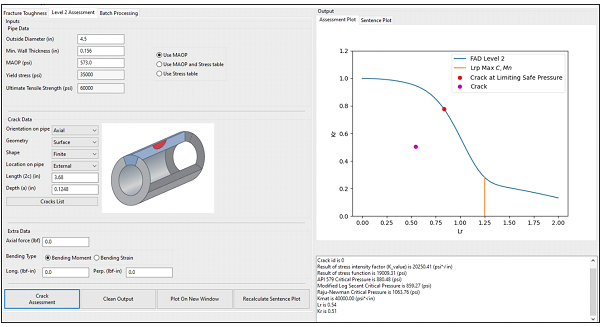5-7-9™ Crack Assessment Software

5-7-9™ Tool Crack Assessment by Kiefner
The integrity of pipelines is fundamental to safe operations. Crack assessment plays a pivotal role in ensuring this integrity. With evolving regulations and the ever-increasing complexities of pipeline networks, there’s a need for advanced methods to assess and manage crack defects.
API 579 Part 9 provides a guideline for assessing crack features, leveraging the failure assessment diagram (FAD) approach. As the industry advances, there’s a growing recognition of the need to incorporate a diverse range of impact energy and toughness inputs. This, combined with the emergence of tools that can handle batch processing, has transformed how defects are addressed, making the process more systematic and prioritized. However, understanding the intricacies of the historical correlation methods in estimating fracture toughness is paramount for optimal integrity management.
Introducing 5-7-9™ by Kiefner
Traditional methods, like ASME B31G and RSTRENG, primarily focus on a 1D river bottom profile of corrosion pitting to derive burst pressure. While these methods provide a baseline, they may not be comprehensive enough for complex corrosion geometries.
Notable Features:
- Versatility in Fracture Toughness Estimates: Whether it’s J-integral, CVN, CTOD, or other fracture toughness estimates, our software is equipped to handle it. The software can compute the Kmat value with sophisticated conversion methods, which is essential for the 579 equations.
- Comprehensive Correlation Methods: Kiefner’s tool is not limited to just one method. It is well-versed with various correlation techniques, including API 579 lower bound, BS 7910, Rolfe Novak, Rofle Barsom, and Wallin Upper Shelf correlations, ensuring a comprehensive assessment.
- Assessment of Multiple Methods: With Kiefner’s software, an analyst can delve into multiple assessment and conversion techniques, aiding in a more informed choice that matches both the available data and the specific material under scrutiny.
By deploying Kiefner’s 5-7-9™ Tool, pipeline operations can ensure they are not just reacting to defects. They are proactively managing them. The blend of technical prowess and a clear understanding of pipeline mechanics ensures that integrity management decisions are not just data-driven, but also future-ready.
For more information regarding the 5-7-9™ tool, please contact us at [email protected].

